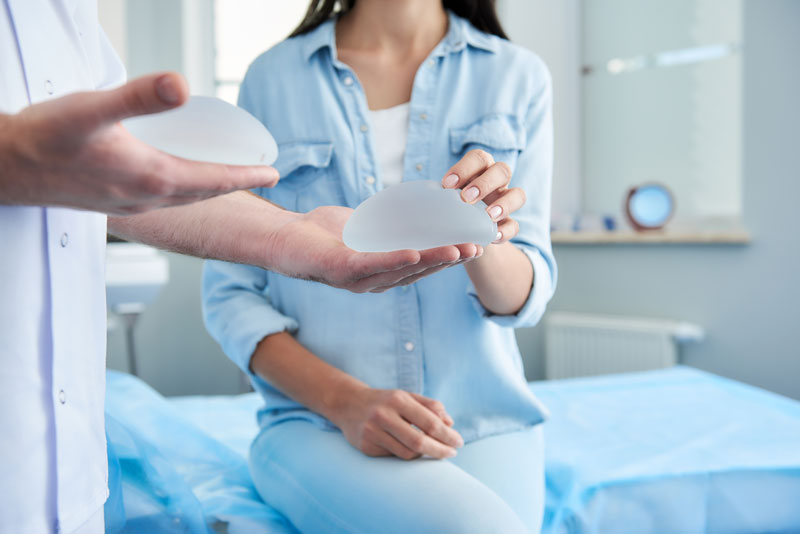Follow @feel_beautiful
Breast Reconstruction San Diego | Breast Cancer Reconstructive Surgery
Breast Reconstruction
It is the plastic surgeon’s unique opportunity to forge a strong, supportive partnership with women who have suffered the misfortune of breast cancer in the effort to restore by the best possible means for each woman those symbols of her femininity that nature has changed or taken from her. The type of breast reconstruction you choose depends on many factors: Your body, individual preferences and expectations, your breast size and shape, the type of breast cancer you have had and treatment required, how you feel about your body after mastectomy, and others. For the vast majority of women, breast reconstruction encompasses a series of procedures, not a single surgical operation. Breast reconstruction is part of your recovery, should never interfere with treatment of breast cancer, and is a process that occurs over time. Modern breast reconstruction techniques, including skin sparing (and nipple sparing) mastectomy, microvascular reconstruction, and other advances have improved the possible result of breast reconstruction beyond what we’ve ever been able to achieve for women in the past. However, because of the complexity of natural breasts and surgical limitations we’ve still not overcome, most women can never be reconstructed to perfection, or even their ideal. For breast cancer patients, the original breast(s) was dangerous, so replacements and breast implants, although not perfect, are an improvement. Our San Diego plastic surgeon, Dr. Laverson, is driven to approach your desired shape and size for your breast reconstruction with the minimum of risk, expense, and time away from your life. You will choose the new breast you want with our San Diego plastic surgeon, Dr. Laverson’s help and guidance. A positive attitude, hope, and understanding what is realistically possible are important.
Breast Reconstruction & Reconstructive Surgery Types
There are two broad categories of breast reconstruction plastic surgery procedures
Breast Implant Based Restoration

Most plastic surgeons perform breast implant reconstruction when a satisfactory result can be achieved by this method, because although serial surgical procedures may be involved, they are of less magnitude (usually outpatient day surgery) than tissue flap reconstruction, and there is no necessity for surgery elsewhere on your body to borrow tissue for transfer to the mastectomy site. Implant-based breast reconstruction and breast cancer reconstruction have some important limitations, however. Thin scar your body forms around a breast implant may become thickened over time causing the reconstructed breast to become firm or hard, to reposition above its proper location, and to become more globular and un-natural in shape. This phenomenon, called “capsular contracture,” also occurs in women who have implants for breast augmentation, but less commonly. Capsular contracture is even more common among women who have had radiation therapy after mastectomy. Women who develop contracture are unhappy with their breast reconstruction. In these cases, plastic surgery to remove the capsule is indicated. At that procedure, the implant may be replaced with another implant, replaced with a tissue expander type implant to enlarge available chest skin area for a better quality restoration, or replaced with a natural tissue flap reconstruction.
Natural Tissue Flap Breast Restoration

(Autologous Tissue Breast Restoration)
Although transfer of skin and fat into the mastectomy defect involves a technically more complex surgical procedure, the final contours are often more natural, and the tissue usually remains softer over time. For many women, autologous breast restoration is a better choice than implant based breast reconstruction procedures. These operations involve transfer of skin and fat to replace breast skin and breast volume removed at mastectomy. Sources of skin and fat for transfer are called “donor sites.” Dr. Laverson transfers skin and fat for breast reconstruction from either the lower abdomen or the back. Both of these donor sites are well established and widely used for post-mastectomy, flap procedures, breast restoration, reconstructive surgery, and breast reconstruction. They often harbor enough extra skin and fat for breast restoration, and scars in these areas will be relatively hidden.
Natural tissue reconstruction has the advantage that it may be contoured to more precisely match the opposite breast. Still, sometimes a “symmetrizing” procedure on the non-mastectomy side to match both breasts is recommended. Secondary outpatient (day surgery) breast reconstruction procedures are usually required to refine the natural tissue flap result over time and to fabricate a nipple and tattoo the areola. With either breast surgery method of breast restoration, complications may develop that necessitate additional procedures and/or unanticipated choices. Generally however, problems are manageable, and breast reconstruction provides a satisfactory breast substitute.
Have your Mastectomy, but Keep your Nipples!
Nipple skin removal is no longer mandatory in all mastectomies. The nipple-areola complex, because it contains terminal ducts, has traditionally been removed as part of every mastectomy procedure for breast cancer. A recently published study from Dr. V Suzanne Klimberg et al of 508 procedures in 293 selected patients compared skin-sparing mastectomy with and without preservation of nipple-areola skin. Comparable complication rates and local-regional tumor recurrence rates were demonstrated between the two groups. Women who had their nipple-areola preserved, not surprisingly, were more pleased with the outcome. Although not all breast cancer patients are eligible, for those with stage I and II breast cancer and for those downstaged with chemotherapy, the nipple skin-sparing mastectomy appears safe and offers a superior cosmetic result with the possibility of one-stage immediate breast reconstruction.
 Steve Laverson MD, Feel Beautiful Plastic Surgery
Steve Laverson MD, Feel Beautiful Plastic Surgery
16903 Avenida De Acacias, Rancho Santa Fe
4.6 87 reviews
-
Cherise Jacobs ★★★★★ 3 weeks ago
Dr Laverson at Feel Beautiful Plastic Surgery is a very skilled surgeon! He's the Best! He also is Amazing at Botox and Fillers! I had an Upper Lip Lift, this is a great and quick procedure done in his office with little downtime. … More Permanent younger looking lips! I highly recommend this procedure! -
Vera Khalitova ★★★★★ 5 months ago
I’ve had a fantastic experience with Dr Laverson and his team. Very competent, professional, communicative, and trustworthy. I love my results already even though they’re not fully healed and can’t stop looking in the mirror! I’m incredibly … More happy and grateful. -
Cindy Bowman ★★★★★ 5 months ago
I had a procedure at Feel Beautiful. Dr. Laverson was extremely attentive and addressed all my concerns. I was nervous on my first appointment and had a lot of questions. He took the time to answer each question in detail. The entire … More staff at Feel Beautiful are kind and caring. My surgery is beautiful and I would highly recommend Dr. Laverson at Feel Beautiful for any cosmetic surgery.
Ask us now or book your consultation.
Contact Us
Contact Us
Address:
Rancho Santa Fe, CA 92067
Phone:
Business Hours:
Mon-Fri
9:00 AM to 5:00 PM

 Book Now
Book Now









